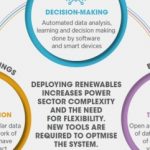Like many other sectors, the energy sector needs employees with digital skills. They need to create the new tools that can match power supply with demand, predict and detect faults in networks, and give greater control to consumers. It’s an essential part of the new world of decarbonisation, with digitalisation enabling the faster integration of renewables, improving grid stability and unlocking greater energy savings. Aloys Nghiem, Marc … [Read more...]
How to handle rapid Grid load growth: Data Centres can set the template for EVs, Buildings, new Industry
Due to their growing power demand, data centres can set a precedent for how to handle rapid load growth in a way that supports the grid and ensures reliable, resilient, carbon-free electricity. In other words, they can set the template for the coming surges in demand from EVs, buildings electrification, and the new rich-world policies of onshoring industry and manufacturing, explain Alexandra Gorin, Roberto Zanchi and Mark Dyson at RMI. Big, … [Read more...]
Big Data’s huge power demand can migrate globally, instantaneously: implications for planning regional capacity and markets
Something is going to make the planning of regional power generation and associated markets even harder: the ability of big data users to shift their demand across the globe quickly, based on price. Ira Joseph at CGEP peers into the near future to ask some difficult questions. When such power demand can “at the push of a button” migrate long distances, how do you make predictions for local capacity needs? And today, market design in most … [Read more...]
Will AI queries increase Data Centre energy use by an order of magnitude?
Data centres globally consumed 220-330 TWh in 2021 (California uses around 278 TWh/year). How much more will they consume if AI takes off, given AI queries consume an order of magnitude more energy, and there are over 5bn internet users worldwide? The first step is to make a decent evidence-based prediction, but the U.S. and the EU are only expected to enforce reporting requirements next year, explains Meredith Fowlie at UC Berkeley’s Energy … [Read more...]
Using Generative AI to speed up and improve the Wind Turbine blade design process
Justin Daugherty at NREL describes research there on using generative AI to accelerate and improve the wind turbine blade design process. To keep up with the pace of change in the market (not just customer demands, but policy regulations and technological innovations), the current method uses simplified low-fidelity modelling because it’s quicker to turn around. But it is also less accurate. Researchers are exploring deep-learning models using … [Read more...]
New AI model predicts 1.5C temperature rise is likely in 2030s even if emissions decline
A new artificial intelligence model is predicting that 2C warming is likely to occur and sooner than expected, even if current low-emissions strategies are successful, explains Josie Garthwaite at Stanford University. The Stanford-developed AI uses “neural network” learning from vast quantities of past data, predicting that the 1.5C threshold is likely to be crossed in the next 10 to 15 years. That’s regardless of how much greenhouse gas … [Read more...]
Using atomic-scale imaging and AI to reduce Battery degradation
Finding ways to extend a battery’s life starts with understanding why they degrade. Andrew Myers writing for Stanford University describes research there that is using new methods of high-resolution X-ray, electron and neutron microscopy to allow direct visualisation of battery materials at the nanoscale. Degradation is mostly caused by the expansion and contraction of the materials. The high resolution images are processed using AI to uncover … [Read more...]
Grid-scale modelling of Distributed Energy Resources and dynamic pricing for all customers
Smart grids can solve multiple problems now and throughout the lifetime of the energy transition. The supply from hundreds (existing + new wind, solar, etc.) and ultimately millions (rooftop solar, EV batteries) of power sources can be matched in real time with demand from all major customer devices (air conditioners, water heaters, batteries, EVs). Dynamic pricing keeps the peaks low and the troughs high. It takes the pressure off total load, … [Read more...]
PET: a toolkit to make existing Coal plants more efficient
Many nations are struggling to phase out coal. Some, like China, are heavily dependent on it, and have more plants in the pipeline to ensure energy security and keep prices low. In other words, a lot of coal will remain in operation for the medium term. Given that, it makes sense to make them more efficient while they are in use. Daisy Chi at ECECP looks at a new set of tools – the Plant Efficiency Toolbox (PET) - that can analyse and optimise a … [Read more...]
Convolutional neural networks: facial recognition AI applied to analysis and design of Advanced Nuclear Reactors
Scientists are looking for new ways to predict how materials survive high temperatures, pressures and corrosion levels, and design new materials that can do so. Temperatures can reach 800 Celsius in parts of solar energy plants and advanced nuclear reactors. Dave Bukey at the Argonne National Laboratory looks at research that uses convolutional neural networks – a type of AI – to uncover patterns in huge data sets. The method is over 2,000 faster … [Read more...]
Improving grid response to support climate targets and increased renewables [Energy Post event video]
We present our video of the online discussion from February 24, 2021 on smartgrid response. Digital, automated, data-driven smart response systems can play a key role in grid security and stability going forward. This makes asset monitoring and controllability - underpinned by the Smart Grid Indicator which is now part of the EU Electricity Directive (Article 59) - a vital link in the chain. Taking part were Vera Silva, COT, General Electric and … [Read more...]
Research into solid electrolytes to improve performance of lithium-ion batteries
If the limits of lithium-ion battery performance are indeed being reached, one way forward is to extend those limits with new materials. Mark Shwartz at Stanford University describes their research into solid electrolytes, which promise to be more energy dense than the standard liquid form. To identify the best compounds, artificial intelligence and machine learning were used rather than the usual and much lengthier trial-and-error experimental … [Read more...]
No more “offsetting”: Google commits to 24/7 locally sourced carbon-free electricity by 2030
By “offsetting” fossil electricity consumed at one data centre through buying green power from somewhere else, Google has been 100% renewable since 2017. But offsetting always has its flaws. In this case, 40% of Google’s actual power still comes from fossil fuels. Google’s new plan, to be 100% green 24/7 straight off the local grid, is designed to solve that. It will also send market signals to increase clean capacity locally, not just where you … [Read more...]
The nexus between data centres, efficiency and renewables: a role model for the energy transition
How much will electricity consumption from data centres grow from today’s 1% of the global total? 40-fold by 2030? Or a more manageable 5-fold? Or less? Sean Ratka and Francisco Boshell at IRENA try to answer this question by looking at the innovations being made by the tech industry to drive down power costs and emissions. The evidence is promising. Though data centre computing output jumped 6- fold between 2010 and 2018, their energy … [Read more...]
AI software to improve Nuclear reactor designs, performance, safety, lifetimes
Nuclear plants have high up-front costs, complex processes occurring all the way down to the molecular level throughout their decades-long lifetimes, and strict safety criteria. Modelling all the parameters and predicting the outcomes has traditionally begun with theory and observation followed by simulations, the results of which are fed back into the next round of theories, and repeated until those results look valid. The quality of the … [Read more...]
















